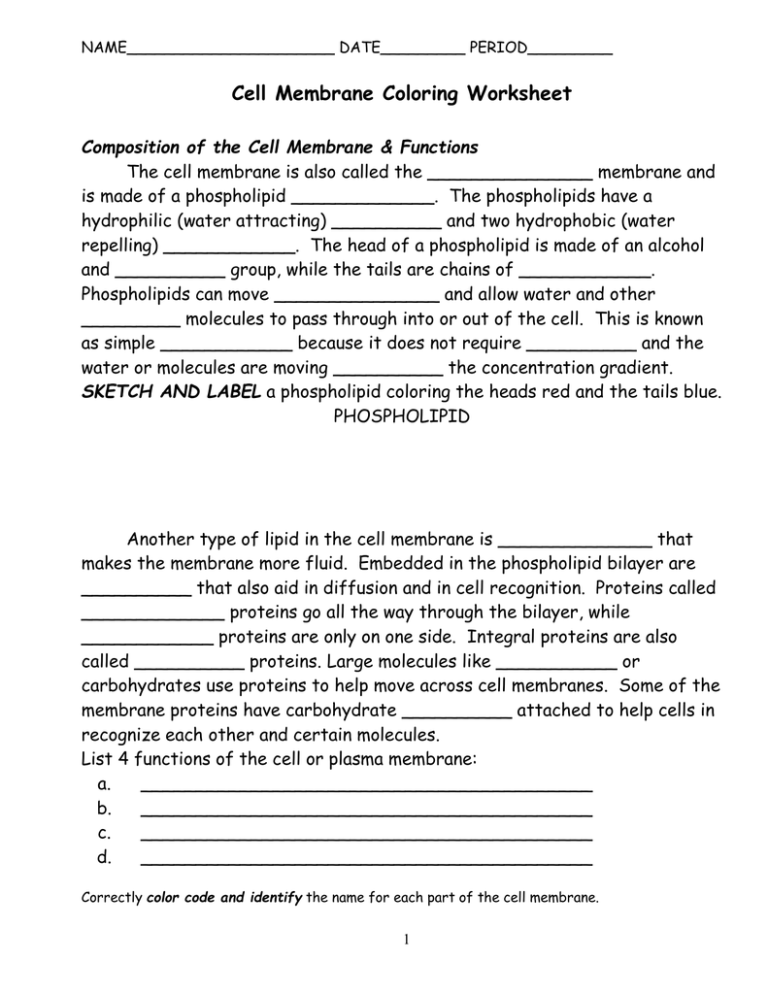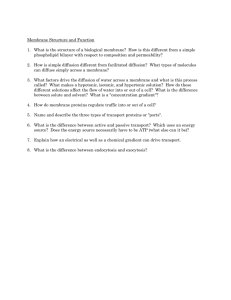Cell Membrane Coloring Worksheet
advertisement

NAME______________________ DATE_________ PERIOD_________ Cell Membrane Coloring Worksheet Composition of the Cell Membrane & Functions The cell membrane is also called the _______________ membrane and is made of a phospholipid _____________. The phospholipids have a hydrophilic (water attracting) __________ and two hydrophobic (water repelling) ____________. The head of a phospholipid is made of an alcohol and __________ group, while the tails are chains of ____________. Phospholipids can move _______________ and allow water and other _________ molecules to pass through into or out of the cell. This is known as simple ____________ because it does not require __________ and the water or molecules are moving __________ the concentration gradient. SKETCH AND LABEL a phospholipid coloring the heads red and the tails blue. PHOSPHOLIPID Another type of lipid in the cell membrane is ______________ that makes the membrane more fluid. Embedded in the phospholipid bilayer are __________ that also aid in diffusion and in cell recognition. Proteins called _____________ proteins go all the way through the bilayer, while ____________ proteins are only on one side. Integral proteins are also called __________ proteins. Large molecules like ___________ or carbohydrates use proteins to help move across cell membranes. Some of the membrane proteins have carbohydrate __________ attached to help cells in recognize each other and certain molecules. List 4 functions of the cell or plasma membrane: a. _________________________________________ b. _________________________________________ c. _________________________________________ d. _________________________________________ Correctly color code and identify the name for each part of the cell membrane. 1 Letter _____ _____ _____ _____ Name/Color Phospholipid bilayer (no color) Integral protein (pink) Fatty acid tails (orange) Phosphate heads (yellow) Letter _____ _____ _____ _____ Name/Color Peripheral protein (red) Cholesterol (blue) Glycoprotein (green) Glycolipids (purple) Match the cell membrane structure or its function with the correct letter from the cell membrane diagram. Letter _____ _____ _____ Structure/Function Attracts water Helps maintain flexibility of membrane Involved in cell-to-cell recognition Letter Structure/Function _____ _____ Repels water Make up the bilayer _____ Help transport certain materials across the cell membrane 2 Osmosis and Tonicity Define osmosis. _____________________________________ In which direction does water move across membranes, up or down the concentration gradient? ________________ Define these 3 terms: a. isotonic_____________________________________ b. hypertonic _____________________________________ c. hypotonic _____________________________________ Use arrows to show the direction of water movement into or out of each cell. Color and label the cell in an isotonic environment light blue, the hypotonic environment yellow, and the hypertonic environment light green. Match the description or picture with the osmotic condition: A. Isotonic _____ solution with a lower solute concentration _____ solution in which the solute concentration is the same B. Hypertonic _____ condition plant cells require _____ condition that animal cells require C. Hypotonic _____ red blood cell bursts (cytolysis) _____ plant cell loses turgor pressure (Plasmolysis) _____ solution with a higher solute concentration _____ plant cell with good turgor pressure _____ solution with a high water concentration 3 Label the tonicity for each solution (isotonic, hypotonic, or hypertonic): ____________ ____________ ____________ _________________ ____________ _________________ Osmosis Osmosis is the diffusion of water across a differentially permeable membrane It occurs when a solute (example: salt, sugar, protein, etc.) cannot pass through a membrane but the solvent (water) can pass through. In areas where the solute concentration is high, the concentration of water molecules is _____. In areas where the solute concentration is low, the concentration of water molecules is _____. If there is no solute, the water is 100% water (high water concentration). Water moves areas where the concentration of water molecules is high (low solute concentration) to areas where the concentration of water molecules is low (high solute concentration). In general, water moves toward the area with a higher solute concentration because it has a lower water concentration. In the container on the left side of the diagram, water will enter the cell because water is more concentrated on the outside. In the center drawing, water is more concentrated inside the cell, so water will move out. If the solute concentration is the same inside as it is out, the amount of water that moves out will be approximately to the amount that moves in. Osmotic pressure is the force of osmosis. In the diagram above, the cell on the left will swell high osmotic pressure. The pressure within the cell is osmotic pressure. 4 Transport Requiring Energy What type of transport is represented by the following picture? _______________________ What energy is being used? ______________ In which direction (concentration gradient), is the movement occurring? _________________ Color the internal environment of the cell yellow. Color and Label the transport proteins red and the substance being moved blue. One type of active transport is called the ________________ pump which helps muscle cells contract. This pump uses ___________ to move ions __________ the concentration gradient. The protein that is used to pump the ions through is called a ____________ protein and it changes its __________ to move the ions across the cell membrane. Label and color the carrier proteins red and the ions green. 5



